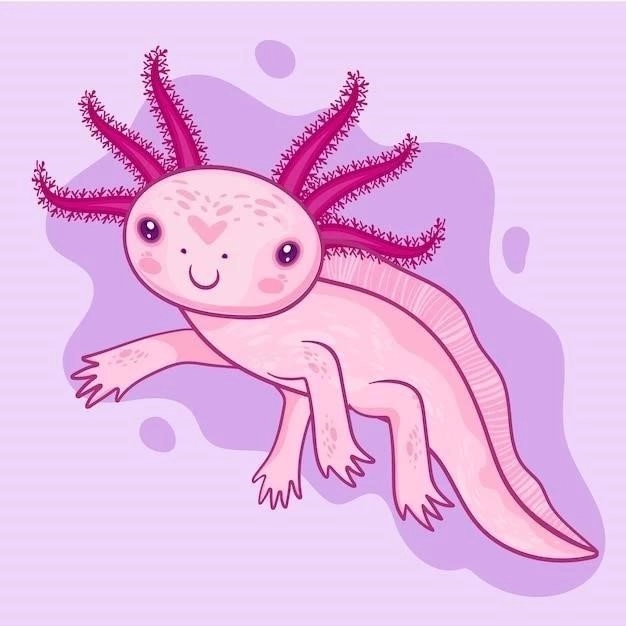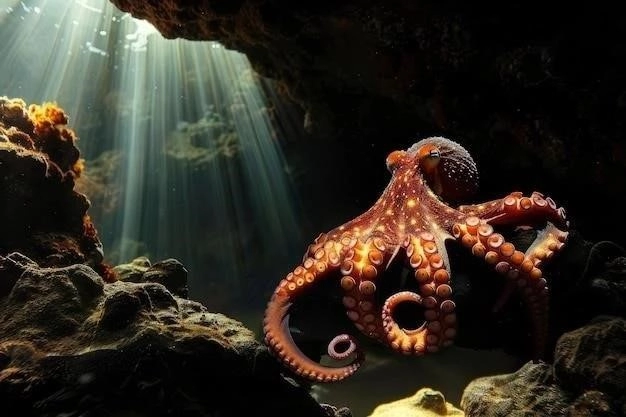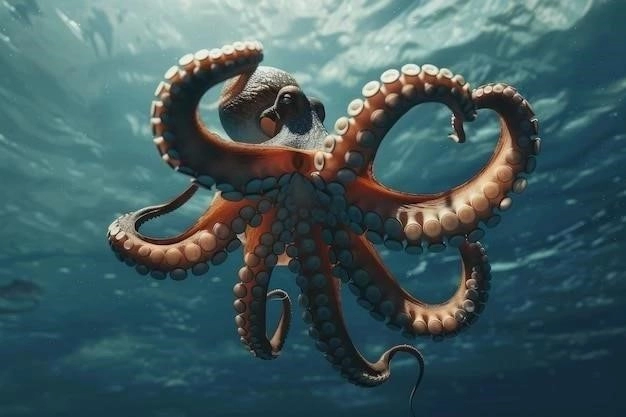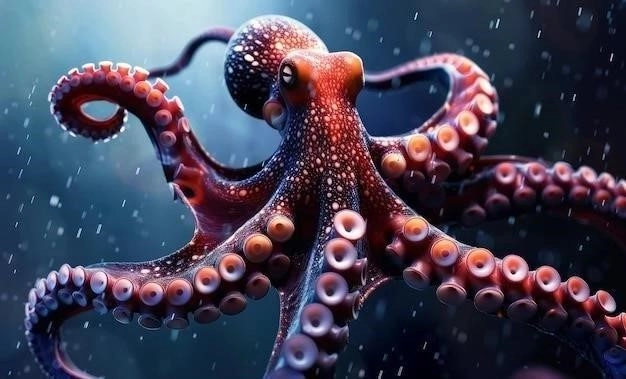The Mimic Octopus: Master of Disguise
The mimic octopus (Thaumoctopus mimicus) stands out among cephalopods for its astonishing ability to imitate a wide array of marine creatures. This remarkable species, found in the Indo-Pacific region, utilizes its sophisticated chromatophores to dynamically change its skin color and texture. Beyond camouflage, the mimic octopus expertly mimics the appearance and movements of various animals, including venomous sea snakes, toxic fish, and even crabs.
Physical Adaptations and Mimicry Techniques
The mimic octopus’s remarkable ability to imitate other species stems from a combination of extraordinary physical adaptations and sophisticated mimicry techniques. These adaptations work in concert to create a visual and behavioral illusion, effectively transforming the octopus into a convincing replica of its chosen model.

Chromatophores: The Foundation of Color Change
Like other cephalopods, the mimic octopus possesses specialized pigment-containing cells called chromatophores. These chromatophores are distributed across the skin in a complex network, each connected to muscles that allow for precise control. By contracting and relaxing these muscles, the octopus can manipulate the size and shape of its chromatophores, thereby altering the colors and patterns displayed on its skin.
Papillae: Sculpting the Skin’s Texture
Beyond color change, the mimic octopus can modify the texture of its skin using specialized structures called papillae. These papillae are small, muscular projections that can be raised or lowered to create bumps, ridges, or even mimic the spiny appearance of certain fish. This ability to manipulate skin texture adds a crucial layer of realism to the mimic octopus’s impersonations.
Body Posture and Movement: Completing the Transformation
The mimic octopus’s mimicry extends beyond visual resemblance. It also expertly imitates the characteristic movements and postures of its chosen models. For instance, when mimicking a venomous sea snake, the octopus will bury its body in the sand, leaving only two arms exposed, which it waves in a serpentine fashion, perfectly mimicking the snake’s movements.
Mimicry Techniques: A Spectrum of Deception
The mimic octopus employs a range of mimicry techniques, each tailored to specific situations and models. These include:
- Batesian Mimicry: This involves imitating a harmful or toxic species to deter predators. For example, the mimic octopus might impersonate a venomous sea snake or a poisonous lionfish.
- Aggressive Mimicry: In this case, the octopus mimics a harmless animal to approach prey. For instance, it might imitate a crab to lure unsuspecting shellfish closer.
- Mullerian Mimicry: This involves imitating a species that shares a common predator with the mimic octopus. Both species benefit from the increased recognition of their shared warning signals.
The mimic octopus’s exceptional capacity for mimicry is a testament to the power of natural selection. This remarkable adaptation has allowed the mimic octopus to thrive in diverse and challenging environments, demonstrating the extraordinary lengths to which evolution can drive the development of survival strategies.

Behavioral Adaptations and Anti-Predator Strategies
The mimic octopus, a master of disguise in the underwater realm, doesn’t solely rely on its physical adaptations for survival. It complements its remarkable mimicry with a suite of sophisticated behavioral adaptations and anti-predator strategies. These behaviors, intertwined with its physical transformations, create a multi-layered defense system that allows it to thrive in the predator-rich waters of the Indo-Pacific.
Predator Recognition and Mimicry Selection
The mimic octopus exhibits an astonishing capacity for predator recognition and mimicry selection. It doesn’t simply cycle through its repertoire of impersonations randomly; rather, it observes and analyzes potential threats, choosing the most effective mimicry based on the predator’s behavior and hunting strategies. For instance, if faced with a damselfish known to avoid sea snakes, the octopus will swiftly adopt the serpentine form and movements of its venomous counterpart.
Adaptive Camouflage: Blending with the Environment

While mimicry of other animals forms a cornerstone of its defense strategy, the mimic octopus is equally adept at adaptive camouflage. It can seamlessly blend into its surroundings, altering its skin color and texture to match the sandy seafloor, coral reefs, or even clumps of algae. This ability to vanish into the background provides a valuable first line of defense, allowing the octopus to avoid detection altogether.
Inking and Jet Propulsion: Evasive Maneuvers
When faced with immediate danger, the mimic octopus can employ the classic cephalopod defenses of inking and jet propulsion. It can release a cloud of ink into the water, creating a disorienting smokescreen that allows it to escape under cover. Additionally, the octopus can forcefully expel water from its mantle cavity, propelling itself swiftly through the water and away from danger.
Nocturnal Behavior: Minimizing Risk
To further reduce the risk of encountering predators, the mimic octopus exhibits predominantly nocturnal behavior. It ventures out to hunt under the cover of darkness, when many of its predators are less active. This strategic use of time minimizes its exposure to potential threats.

Burrowing and Hiding: Seeking Refuge
When not actively hunting or defending itself, the mimic octopus seeks refuge in burrows, crevices, or under rocks. This behavior provides a safe haven from predators and allows the octopus to conserve energy and avoid unnecessary encounters.
The mimic octopus’s intricate blend of physical adaptations, behavioral flexibility, and anti-predator strategies highlights the remarkable evolutionary pressure that has shaped this extraordinary species. Its ability to seamlessly transition between mimicry, camouflage, and evasive maneuvers solidifies its position as one of the most fascinating examples of adaptive evolution in the animal kingdom.
Evolutionary Origins and the Development of Mimicry
The mimic octopus’s extraordinary talent for impersonation, while captivating to observe, represents more than just an intriguing spectacle. It stands as a testament to the power of natural selection and provides a fascinating glimpse into the evolutionary processes that have shaped this species’ remarkable adaptations.
A Legacy of Camouflage and Color Change

The mimic octopus’s ancestors, like other cephalopods, possessed chromatophores—specialized pigment cells—allowing for dynamic color change. This ancestral trait, primarily used for camouflage, laid the foundation for the evolution of more sophisticated mimicry. Over time, variations in chromatophore distribution, control mechanisms, and behavioral patterns emerged, driven by the selective pressures of predator-prey interactions.
The Gradual Refinement of Mimicry
It is highly unlikely that the mimic octopus’s diverse repertoire of impersonations emerged fully formed. Instead, it likely arose through a gradual process of refinement, with each incremental improvement in resemblance to a specific model offering a survival advantage. Those individuals with slight variations that enhanced their resemblance to a venomous fish, for instance, would have been more likely to avoid predation, passing on their advantageous traits to their offspring.
The Role of Natural Selection and Genetic Variation
Natural selection, acting upon the inherent genetic variation within the mimic octopus population, played a pivotal role in shaping this species’ mimicry. As individuals with more convincing impersonations were more likely to survive and reproduce, their genes, carrying the blueprint for these advantageous traits, became more prevalent within the gene pool, gradually sculpting the species’ remarkable capabilities.
Unraveling the Genetic Underpinnings

While the precise genetic mechanisms underlying the mimic octopus’s transformative abilities remain an active area of research, it’s likely that a complex interplay of genes influences chromatophore development, neural control of skin patterns, and the behavioral repertoire associated with each mimicry. Unraveling these genetic underpinnings promises to shed further light on the evolutionary journey of this remarkable creature.
An Ongoing Evolutionary Tale
The evolutionary story of the mimic octopus is far from over. As environmental pressures continue to shape this species’ trajectory, it’s conceivable that its repertoire of mimicry will continue to evolve, potentially incorporating new models into its already impressive repertoire. Studying this ongoing adaptation offers invaluable insights into the dynamic interplay between evolution, behavior, and survival in the ever-changing theater of the natural world.
The Mimic Octopus’s Diet and Hunting Strategies
While the mimic octopus is best known for its astonishing mimicry, its dietary habits and hunting strategies are equally remarkable, showcasing a cunning blend of deception, agility, and adaptability. This master of disguise doesn’t just utilize its transformative abilities for defense; it leverages them as potent tools for securing its next meal in the challenging underwater hunting grounds.
A Carnivorous Palate: Targeting a Variety of Prey
The mimic octopus, a carnivorous predator, boasts a diverse palate that includes a range of small marine creatures. Fish, crustaceans like crabs and shrimp, and other invertebrates like worms and mollusks all feature prominently on its menu. This adaptable diet allows the mimic octopus to thrive in a variety of habitats and exploit a range of food sources.
Ambush Predator: Patience and Precision
As a predominantly ambush predator, the mimic octopus relies on stealth and patience to secure its prey. Rather than engaging in prolonged chases, it prefers to lie in wait, concealed among the sand, coral, or algae, patiently waiting for an opportune moment to strike.
Mimicry in Action: Luring Unsuspecting Prey
The mimic octopus’s remarkable ability to impersonate other animals isn’t limited to defense; it also plays a crucial role in its hunting strategies. It can, for instance, mimic the appearance and movements of a harmless crab, luring unsuspecting shellfish closer, only to strike with lightning speed when its prey is within reach.
Venomous Bite: Subduing Prey with Toxins

Once it captures its prey, the mimic octopus delivers a venomous bite using its sharp beak, injecting a paralyzing toxin that quickly immobilizes its victim. This venom, common to most octopuses, allows the mimic octopus to subdue its prey swiftly and efficiently, minimizing the risk of injury to itself.
Adaptive Hunting Techniques: Exploiting Diverse Environments
The mimic octopus’s hunting techniques aren’t limited to a single approach; it displays remarkable adaptability, modifying its strategies based on the specific prey it targets and the environment it inhabits. It can blow jets of water into the sand to uncover hidden prey, use its arms to probe crevices for crabs and shrimp, and even flush out small fish hiding among coral reefs.
The mimic octopus’s success as a hunter highlights the remarkable interplay between its physical adaptations, behavioral flexibility, and dietary opportunism. By seamlessly blending camouflage, deception, and predatory prowess, this underwater chameleon has secured its place as a formidable and cunning hunter in the intricate food webs of the ocean.










